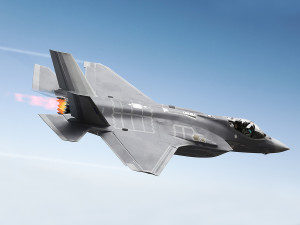First F-35 Jets Lacks Ground-Combat Punch of 1970s-Era A-10s
©2015 Bloomberg News
NMTHUZ6JIJV2
(Bloomberg) — The first F-35 jets ready for combat won’t be able to protect forces in ground combat as well as the nearly 40-year-old A-10s the Pentagon wants to retire, according to the Defense Department’s chief weapons tester. Compared with the lumbering A-10, known as the Warthog, the initial F-35s made by Lockheed Martin Corp. will be handicapped by limits on how many weapons they can carry, flying at night and spotting targets as well as how long they can remain over them, Michael Gilmore, director of operational testing, said in a statement prepared for a House Armed Services subcommittee hearing. The Marine Corps intends to declare the first of its F-35B planes ready for initial combat as soon as July. Gilmore underscored the limitations on those early fighters by comparing them to the A-10, which first flew in 1976 and continues to protect U.S. and allied ground forces. The Pentagon is trying for the second consecutive year to persuade Congress to permit the A-10’s retirement. Gilmore said the initial F-35s will fall short because “of the combined effects of digital communications deficiencies, lack of infrared pointer capability” to distinguish friendly from hostile forces and an inability to confirm the Global Positioning Satellite ground coordinates programmed into its two air-to-ground bombs.
Cost Questioned
The Armed Services panel, conducting its annual review of the $391.1 billion F-35 program, the Pentagon’s costliest, also heard testimony from the plane’s program manager and the U.S. Government Accountability Office. The GAO, the investigative arm of Congress, raised questions about the F-35’s affordability as production ramps up from 34 planes this year to a peak of 120 in 2021. That will require spending an average of $12.7 billion a year for more than two decades, said Michael Sullivan, the GAO’s director for acquisition and sourcing management. As the F-35 competes with other weapons programs for limited funding, “something has to give, and a lot of times it’s quantities,” Sullivan told the subcommittee. Air Force Lieutenant General Christopher Bogdan, who oversees the F-35 program for the Pentagon, defended its progress and said costs have stabilized. “We’re making slow but steady progress on all fronts, and each day the program is improving,” Bogdan said.
Flawed Computers
One major problem yet to be solved is the plane’s computer information system that’s designed to alert pilots to logistical problems, he said, adding that he has a plan to improve it through a redesign. The subcommittee chairman, Republican Representative Michael Turner of Ohio, said he was troubled to learn that 80 percent of that system’s alerts have been “false positives.”
Gilmore’s testimony about the F-35’s limitations in performing close-air support — loitering at low altitudes to strike moving targets — comes at an awkward time for the Air Force as it seeks to retire its top close-air support fighter, the A-10 Warthog, to save about $4 billion through 2020.
“The A-10 can take hits that an F-35 couldn’t take,” Gilmore said when asked about the new plane’s survivability. As a result, the F-35 would need to “stand off,” or keep a greater distance, from potential enemy fire, he said. Representative Martha McSally of Arizona, a former A-10 pilot who’s trying to save it, said that may be dangerous. “There will be times in the future when you must get down and dirty with the guys on the ground,” the Republican said. “You cannot stand off” in all cases.
Advanced Software
Gilmore acknowledged that close-air support is only one of the stealthy F-35’s missions, and that it will have much better capabilities later in this decade after more advanced software is installed.
In the meantime, the A-10 has been flying missions against Islamic State terrorists in the Middle East, and a dozen of them will be used for training in Romania in a signal of deterrence to Russia after its support for rebels in Ukraine. The A-10 was designed during the Cold War in part to kill Soviet tanks if they attacked U.S. and allied forces in Europe.
To contact the reporters on this story: Tony Capaccio in Washington at acapaccio@bloomberg.net; David Lerman in Washington at dlerman1@bloomberg.net To contact the editors responsible for this story: John Walcott at jwalcott9@bloomberg.net Larry Liebert








No Comment